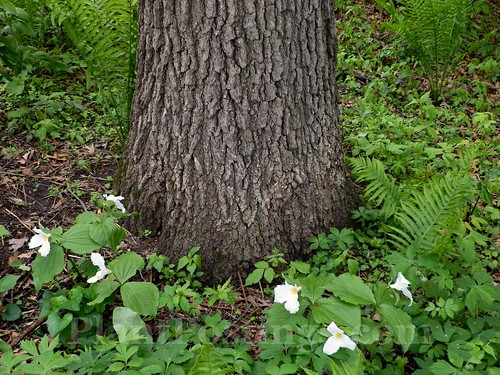
Back in 2012, we had a major drought here in the Madison area and much of Southern Wisconsin. I realize folks in the Southwest have them frequently, but a drought of this magnitude is rare for us. Our plants, animals, and people really struggle when it happens.
It didn't rain, at all, from mid-June through mid-August, and not much before and after that. We didn't officially come out of the drought until April 2013.
I mention all of this, because the drought set back several areas of the garden, including one near a large Oak tree (shown above) that was brown and dead, even by the next summer.
So, I did a little inexpensive experiment. I try to introduce only native plants back in the woods, to keep the area as close to "natural" as possible. I seeded the area with Pennsylvania Sedge (Carex pensylvanica) and Virginia Bluebells (Mertensia virginica). Both are native, rabbit-resistant, woodland plants, and they tolerate some summer drought. Plus, I like them.
Much to my surprise, by the next summer, the area was filled with Virginia Creeper (Parthenocissus quinquefolia), Virginia Waterleaf (Hydrophyllum virginianum), Ostrich Ferns (Matteuccia struthiopteris), and even Great White Trilliums (T. grandiflorum) and other native plants that hadn't been there before!
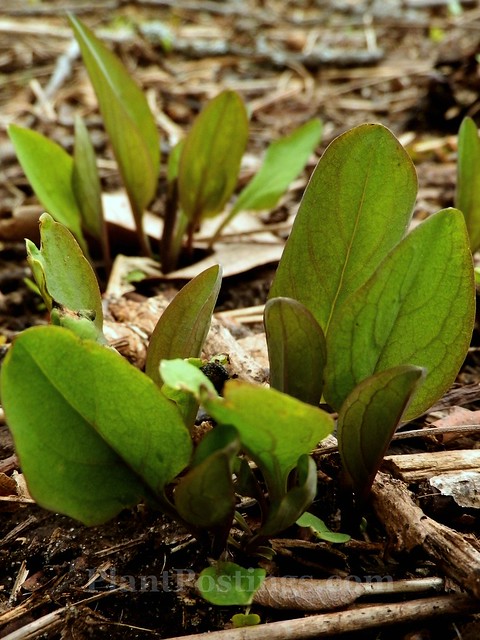
Meanwhile, the Pennsylvania Sedge was spotty, and the Virginia Bluebells looked like this, with no blooms, for several years.
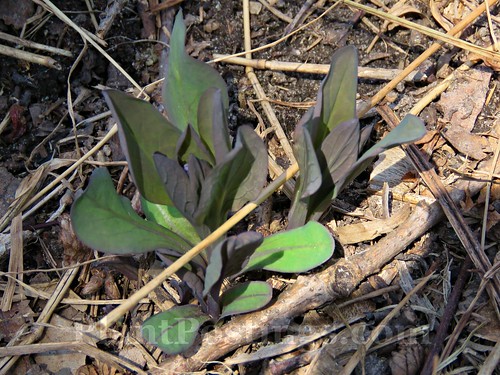
Until now! Do you see it?
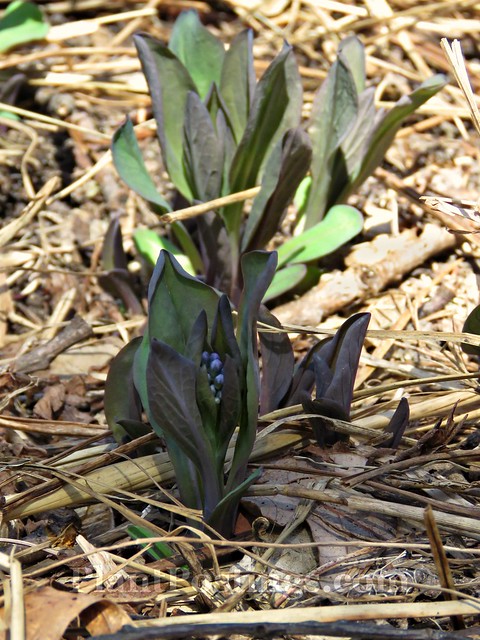
How about now?
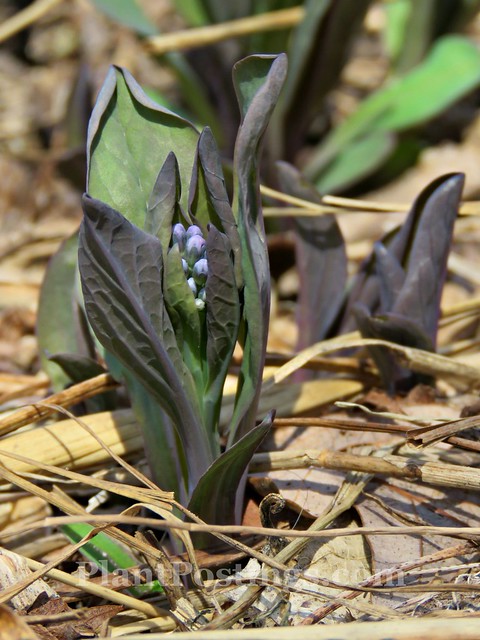
Yes! Buds!

Several of the Virginia Bluebells will bloom very soon! Cheers!
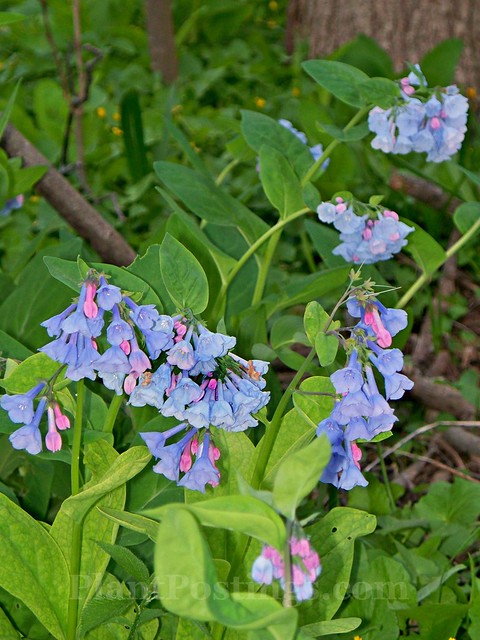
Maybe someday in the not-too-distant future, I'll have a healthy patch of them back there, like this grouping I saw during a hike.
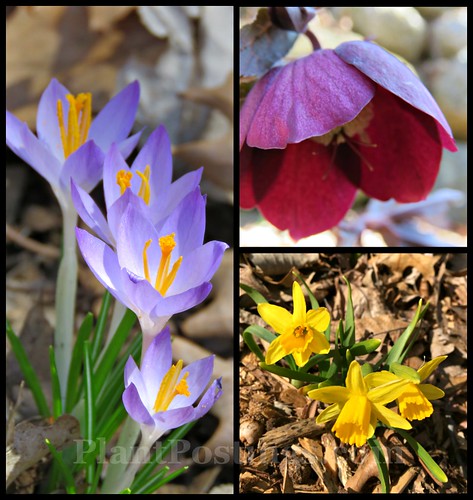
Oh, by the way, the plants that were snowed in at my last post survived, and are now thriving with our near-perfect springtime weather. Boy, they're tough!
I'm linking this post--because of the native, about-to-bloom Virginia Bluebells--to Gail's Wildflower Wednesday meme, over at Clay and Limestone. Check it out!
Congratulations. I am impressed with your patience...your babies are beautiful.
ReplyDeleteThanks, Gail. I am very happy that they finally formed flower buds. Thanks for hosting Wildflower Wednesday!
DeleteI'd be proud and thrilled to have put so much back into nature Beth - seems like the decimation by drought did a service to the woodland since all those other plants have appeared p.s. I adore Trilliums
ReplyDeleteHi Laura: Yes, before Europeans settled here, natural and human-set fires were common. Often, the fire cleaned things up and more wildflowers filled in. That's what happened here, in addition to a little help from this human to add Mertensias to the mix. I love Trilliums, too, and I was thrilled to see new ones in that spot! (We always have some, but new ones are icing on the cake.)
DeleteSo excited for you! It seems like much of gardening involves either patience or persistence--or both!
ReplyDeleteThanks, Kathy! Yes, that is so true. Patience and persistence are required!
DeleteGreat photos!
ReplyDeleteHappy Wildflower Wednesday!
Thank you, Lea! It's a special celebration. :)
DeleteWonderful Beth! Both your patient efforts and your lovely photos. I also like your clever text and insightful concept. You have become my garden blogging hero!
ReplyDeleteThanks! You are sweet. Gardening is the best hobby. :)
DeleteNo rain from June through August is just a normal summer for us but I appreciate that any significant departure from your local norms poses challenges. (I'm still mourning our paltry winter rains this season.) I've been schooling myself in patience too - a single year and often even 2 or 3 simply isn't enough to realize the potential of many plants. I'm glad the pretty Virginia bluebells came through for you at last!
ReplyDeleteI think I could live with lack of rain for a few months (although it would be hard)...if I had mostly succulent plants. Our gardens (and natural areas) here are filled with plants that need more moisture. With that said, I have been adding more xeric and drought-tolerant plants after the 2012 drought. I agree: Some plants take a while to settle in--especially when started from seed! :)
Deletewhen i started to read your post felt sad of hearing the drought and the struggle you and others had. But as i came down, by seeing the flowers i became happy. :)
ReplyDeleteI'm glad it wasn't a complete downer. ;-) To be honest, I was very depressed by about mid-July 2012. When the rain finally came, neighbors were out dancing in the street! Really!
DeleteMy bluebells come and go. I hope yours make a massive display some year soon. Love those white trillium.
ReplyDeleteInteresting and good to know, Lisa. That's how the Trilliums are here. Some years they seem to blanket the entire woods, other years we have only a few. I will try to temper my expectations similarly with the Bluebells.
DeleteGood to see your patience paid off! I have wanting to plant some Virginia bluebells, especially after attending a talk about bees when the presenter mentioned they are a great food source for them in early spring.
ReplyDeleteHonestly, I kept thinking...oh well, the area filled in with Trilliums! The Bluebells kept coming back, so I figured no harm done. To see them finally blooming is a thrill. I had heard that about the bees, too. They are the earliest-blooming native plant I have here. Of course, the spring bulbs and the Hellebores are the first bloomers...and the neighbors' Red Maples. :)
DeleteHow wonderfully to be gifted with trilliums. An endorsement of your kind and thoughtful gardening!
ReplyDeleteOh yes, Trilliums are a gift, Diana. Except I didn't do anything to encourage them. They thrive here, and took over on their own in the drought-ravished area. I was thinking Bluebells and Sedges, but nature picked Trilliums (and several other native plants, including my seeded Bluebells). ;-)
DeleteLoved this . . .
ReplyDeleteFlowering promises . . .
In a way it gives credence to hope and trust . . .
I too enjoy the naturalness of our wooded area behind our house . . .
I looked a few days ago for trillium . . .
This encourages me to go look again . . . with hope!
Thanks, Lynne. I know we have similar plots with similar plants. Such a joy, right?! Happy hunting for wildflowers!
DeleteHurray for those buds! Now that's what I call patience :) We had a drought here as well - can't recall if it was at the same time as yours, but may very well have been. I never water the grass and that's the year that I learned that there's a big difference between dormant grass and dead grass. So if we have no rain for longer than a month, I now grudgingly get the hoses out.
ReplyDeleteHa! I didn't have much choice, Margaret. (I would never say no to Trilliums!) But I sure was thrilled to see the Bluebells are finally blooming, too. I don't remember if your drought was the same year, but I wouldn't be surprised. 2012 was the year we installed rain barrels. Of course, they didn't help that year. And by the next year, we didn't have a drought. LOL. We cut way back on our water use in 2012--I only watered the areas near the house once a week. Some of our grass went dormant and some died and had to be re-seeded. Not fun.
DeleteWould you believe I can hardly remember that drought? I well remember the one in 1988 because that's the year we got married and the weather broke just before our Sept. wedding. Funny what triggers memories. Most of my things that were snowed under are doing fine with little damage. I do however seem to have Virginia waterleaf everywhere I looks. Very pretty but not a plant I want at all.
ReplyDeleteFunny: I don't remember the 1988 drought, although I remember I was hot. I was pregnant that summer and I didn't do much heavy lifting. We did hike a few times, though, and I remember thinking how uncomfortable it was. Same here, re: the recent snows. Yay. I understand your thoughts about Va. Waterleaf. I only have it in the woods, where I don't really garden much--I just observe. But I know it's a very opportunistic native plant. ;-)
DeleteNo rain for months in the summer is normal for us. I hate it. Your idea to reseed with native plants was brilliant because it saved you from needing to clear the area. Good job.
ReplyDeleteThanks, Jeannie. I can't imagine no rain during the summer...every summer! But part of the problem would be that our entire ecosystem is built around plants that need at least some water each month. I have added more xeric and drought-tolerant plants since 2012. Apparently, we are likely to see more summers like that in the future, which makes me sad.
DeleteOh, how lovely, Beth. Droughty summers are so difficult for plants, whether native or not. Here in our last days in Italy, I’ve been watering our HomeExchange partner’s garden full of roses and a few hydrangeas before we leave. Yikes. The climbing roses, yes, but the shrub roses? Hydrangeas? In a Mediterranean summer? At least I was able to weed out all of the winter annuals for them!
ReplyDeleteThank you, Lisa. I'm so glad you had a beautiful trip to Italy! Someday, I hope to get back there again. We loved it, too. Yeah, the drought here in S. WI was rough. People probably don't realize that our plants, insects, animals, and ecosystems don't handle droughts well. Some of us are adding more xeric plants in recent years, but still a severe drought is unusual here in the Midwest. I think it's probably unusual and tough for you in the Carolinas, too, right?
DeleteHydrangeas in a mediterranean summer - I see optimistic gardeners here too. Zone denial much?
DeleteIt's always a challenge, right? But to add plants that are way out of their range or conditions makes it even more risky.
DeleteWell done, Beth. My mom has been creating a woodland garden as well. She has been patient too. Last spring was the highlight for her when many plants bloomed.
ReplyDelete:-)
Thank you, Carla. Actually, I pretty much just let the back woods happen naturally. I added some seed to that particular area, but for the most part, nature decided on Trilliums and Va. Creeper mixed in with the Va. Bluebells and sedges (seeds) that I scattered. :) Yay for your mom!!
DeleteAnother post with the Virginia Waterleaf, time to check it out. So glad your area by the Oak tree has come back...natives, natives, natives!! I planted some trillium (3 of them) and know one has put up leaves...need to look for the others.
ReplyDeleteAgreed: More native plants! My garden isn't exclusively native plants, but it's moving in that direction. You've been busy with your landscaping projects, Janet--I'm so impressed! I'll look forward to updates throughout the growing season!
DeleteCongratulations on the Mertensia! Such a great plant.
ReplyDeleteThank you, Jason. I'm very happy that they're blooming. And more have popped up since I posted this. It will be fun to check them out later this week.
DeleteCongrats on the budding bluebells! Kudos to natives and to the smart gardeners who plant them. Lovely photos--as usual.
ReplyDeleteThank you, Michelle. I actually simply scattered some seed and added a little light layer of top soil. The Trillium seeds and/or rhizomes liked it, too. ;-) Mother Nature took over with a little help, maybe.
DeleteHi Beth, So glad to hear you're having spring! The Trillium are striking and Virginia Bluebells are lovely. I'm glad some you planted made it. I'm becoming more enamored with native plants.
ReplyDeleteHi Sally: Spring has sprung! Everything's behind schedule this year, but I think the next two weeks will bring an explosion of blooms all at once. There are so many great native plants to add to our gardens and encourage on our properties. :)
DeleteThis is a wonderful story Beth, a tribute to native plants and to you as a caring gardener. Congratulations. P. x
ReplyDeleteThank you, Pam. I really didn't have to do much (except be patient ;-) ). I simply scattered some seed and a little top soil, and then watered a little extra the first year. Mother Nature cooperated. :)
DeleteI love your trilliums and oh how exciting to grow the beautiful mertensia. I tried it once but it doesn't like my soil. Such a gorgeous colour. Well done.
ReplyDeleteI'm so happy it has established itself and is finally blooming here. I knew my soil and the conditions should be right, because it grows wild around here. Just a little patience was required before it settled in. ;-)
DeleteI cannot wait to see your VA bluebells...mine are just peaking out with beginning sprouts....so far behind with our spring....but yours is looking up!
ReplyDeleteCrazy spring, Donna! Today was super cold and rainy, but the milkweed is poking out of the ground. The weather doesn't know if it wants to be winter or summer. Not must spring weather this year.
DeleteIt is so good to be reminded of the importance of patience! You never know.
ReplyDeleteYes, I need to keep reminding myself, Pat! ;-)
DeleteCongratulations on you Virginia Bluebell buds. Good things are worth waiting for! Speaking of good things, your trillium are gorgeous.
ReplyDeleteThanks, Peter. I'm thrilled with the VA Bluebells! The Trilliums in this particular spot were a surprise, although they pop up here and there throughout the woodland each year. I love them, too. :)
Delete